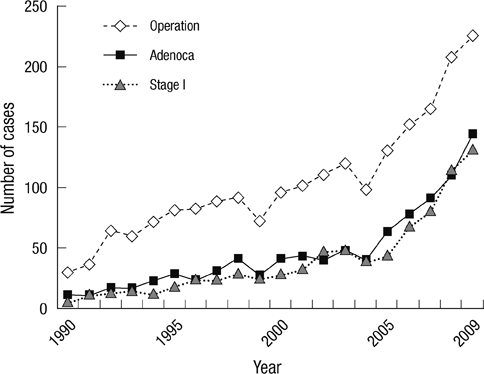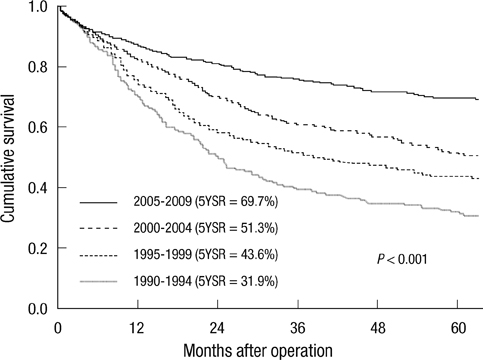J Korean Med Sci.
2012 Dec;27(12):1486-1490. 10.3346/jkms.2012.27.12.1486.
Changes in the Demographics and Prognoses of Patients with Resected Non-Small Cell Lung Cancer: A 20-Year Experience at a Single Institution in Korea
- Affiliations
-
- 1Department of Thoracic and Cardiovascular Surgery, Yonsei University College of Medicine, Seoul, Korea. kychu@yuhs.ac
- 2Department of Thoracic and Cardiovascular Surgery, Eulji University School of Medicine, Daejeon, Korea.
- KMID: 2157971
- DOI: http://doi.org/10.3346/jkms.2012.27.12.1486
Abstract
- The demographics and prognosis of non-small cell lung cancer patients have changed during the last few decades. We conducted this study to assess the change in demographics and prognosis in resected non-small cell lung cancer patients during a 20-yr single-institution study in Korea. We retrospectively reviewed the medical records of 2,076 non-small cell lung cancer patients who underwent pulmonary resection between 1990 and 2009. Their clinical characteristics and survival were analyzed over a five-year period. With time, the proportions of female, adenocarcinoma, stage IA, and lobectomy patients increased, whereas the proportions of male, squamous cell carcinoma, stage IIIA, and pneumonectomy patients decreased. These demographic changes caused improved prognosis. The five-year survival rate of all patients was 53.9%. The five-year survival rate increased from 31.9% in 1990-1994, to 43.6% in 1995-1999, 51.3% in 2000-2004, and 69.7% in 2005-2009 (P < 0.001). In conclusion, among patients with resected non-small cell lung cancer, the proportions of female, adenocarcinoma, stage IA, and lobectomy patients have increased, and the five-year survival rate has gradually improved during the last 20 yr in Korea.
Keyword
MeSH Terms
Figure
Reference
-
1. Jemal A, Siegel R, Xu J, Ward E. Cancer statistics, 2010. CA Cancer J Clin. 2010. 60:277–300.2. National Cancer Information center. Cancer statistics, 2009. accessed on December 30, 2011. Available at http://www.cancer.go.kr/ncic/cics_f/02/022/index.html.3. Jung KW, Park S, Kong HJ, Won YJ, Boo YK, Shin HR, Park EC, Lee JS. Cancer statistics in Korea: incidence, mortality, survival, and survival in 2006-2007. J Korean Med Sci. 2010. 25:1113–1121.4. Shirakusa T. Postoperative results under the new stage classification of lung cancer: the additional reports for those of JACS in 1996. Kyobu Geka. 2000. 53:894–898.5. Goya T, Asamura H, Yoshimura H, Kato H, Shimokata K, Tsuchiya R, Sohara Y, Miya T, Miyaoka E. Japanese Joint Committee of Lung Cancer Registry. Prognosis of 6644 resected non-small cell lung cancers in Japan: a Japanese lung cancer registry study. Lung Cancer. 2005. 50:227–234.6. Asamura H, Goya T, Koshiishi Y, Sohara Y, Eguchi K, Mori M, Nakanishi Y, Tsuchiya R, Shimokata K, Inoue H, et al. A Japanese Lung Cancer Registry study: prognosis of 13,010 resected lung cancers. J Thorac Oncol. 2008. 3:46–52.7. Sawabata N, Miyaoka E, Asamura H, Nakanishi Y, Eguchi K, Mori M, Nomori H, Fujii Y, Okumura M, Yokoi K. Japanese Joint Committee for Lung Cancer Registration. Japanese Lung Cancer Registry Study of 11,663 surgical cases in 2004: demographic and prognosis changes over decade. J Thorac Oncol. 2011. 6:1229–1235.8. Goldstraw P, Crowley J, Chansky K, Giroux DJ, Groome PA, Rami-Porta R, Postmus PE, Rusch V, Sobin L. International Association for the Study of Lung Cancer International Staging Committee. Participating Institutions. The IASLC Lung Cancer Staging Project: proposals for the revision of the TNM stage groupings in the forthcoming (seventh) edition of the TNM Classification of malignant tumours. J Thorac Oncol. 2007. 2:706–714.9. Mountain CF, Dresler CM. Regional lymph node classification for lung cancer staging. Chest. 1997. 111:1718–1723.10. Devesa SS, Bray F, Vizcaino AP, Parkin DM. International lung cancer trends by histologic type: male: female differences diminishing and adenocarcinoma rates rising. Int J Cancer. 2005. 117:294–299.11. Lam WK, White NW, Chan-Yeung MM. Lung cancer epidemiology and risk factors in Asia and Africa. Int J Tuberc Lung Dis. 2004. 8:1045–1057.12. Perng DW, Perng RP, Kuo BI, Chiang SC. The variation of cell type distribution in lung cancer: a study of 10,910 cases at a medical center in Taiwan between 1970 and 1993. Jpn J Clin Oncol. 1996. 26:229–233.13. Seow A, Duffy SW, Ng TP, McGee MA, Lee HP. Lung cancer among Chinese females in Singapore 1968-1992: time trends, dialect group differences and implications for aetiology. Int J Epidemiol. 1998. 27:167–172.14. Choi JH, Chung HC, Yoo NC, Lee HR, Lee KH, Choi W, Lim HY, Koh EH, Kim JH, Roh JK. Changing trends in histologic types of lung cancer during the last decade (1981-1990) in Korea: a hospital-based study. Lung Cancer. 1994. 10:287–296.15. Lam KY, Fu KH, Wong MP, Wang EP. Significant changes in the distribution of histologic types of lung cancer in Hong Kong. Pathology. 1993. 25:103–105.16. Morita T. A statistical study of lung cancer in the annual of pathological autopsy cases in Japan, from 1958 to 1997, with reference to time trends of lung cancer in the world. Jpn J Cancer Res. 2002. 93:15–23.17. Westeel V, Choma D, Clément F, Woronoff-Lemsi MC, Pugin JF, Dubiez A, Depierre A. Relevance of an intensive postoperative follow-up after surgery for nonsmall cell lung cancer. Ann Thorac Surg. 2000. 70:1185–1190.18. Naruke T, Tsuchiya R, Kondo H, Asamura H. Prognosis and survival after resection for bronchogenic carcinoma based on the 1997 TNM-staging classification: the Japanese experience. Ann Thorac Surg. 2001. 71:1759–1764.19. van Rens MT, de la Rivière AB, Elbers HR, van Den Bosch JM. Prognostic assessment of 2,361 patients who underwent pulmonary resection for non-small cell lung cancer, stage I, II, and IIIA. Chest. 2000. 117:374–379.20. Koike T, Terashima M, Takizawa T, Haga M, Kurita Y, Yokoyama A, Misawa H. The influence of lung cancer mass screening on surgical results. Lung Cancer. 1999. 24:75–80.21. Fang D, Zhang D, Huang G, Zhang R, Wang L, Zhang D. Results of surgical resection of patients with primary lung cancer: a retrospective analysis of 1,905 cases. Ann Thorac Surg. 2001. 72:1155–1159.22. Yoshino I, Baba H, Fukuyama S, Kameyama T, Shikada Y, Tomiyasu M, Suemitsu R. A time trend of profile and surgical results in 1,123 patients with non-small cell lung cancer. Surgery. 2002. 131:S242–S248.
- Full Text Links
- Actions
-
Cited
- CITED
-
- Close
- Share
- Similar articles
-
- Analysis of prognositic factors and long-term survival according to the pattern of lymph node metastasis in surgically resected N2 Non-Small cell lung cancer(NSCLC)
- Adjuvant Chemotherapy for Completely Resected Non-Small Cell Lung Cancer
- Recent Trends in Demographics, Surgery, and Prognosis of Patients with Surgically Resected Lung Cancer in a Single Institution from Korea
- Surgical Outcomes in Small Cell Lung Cancer
- Postoperative radiation therapy in resected stage II and IIIA non-small cell lung cancer(Yonsei cancer center 20-year experience)



